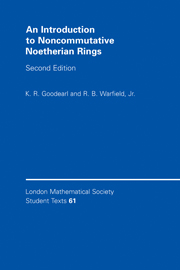Book contents
- Frontmatter
- Contents
- Introduction to the Second Edition
- Introduction to the First Edition
- Prologue
- 1 A Few Noetherian Rings
- 2 Skew Polynomial Rings
- 3 Prime Ideals
- 4 Semisimple Modules, Artinian Modules, and Torsionfree Modules
- 5 Injective Hulls
- 6 Semisimple Rings of Fractions
- 7 Modules over Semiprime Goldie Rings
- 8 Bimodules and Affiliated Prime Ideals
- 9 Fully Bounded Rings
- 10 Rings and Modules of Fractions
- 11 Artinian Quotient Rings
- 12 Links Between Prime Ideals
- 13 The Artin-Rees Property
- 14 Rings Satisfying the Second Layer Condition
- 15 Krull Dimension
- 16 Numbers of Generators of Modules
- 17 Transcendental Division Algebras
- Appendix. Some Test Problems for Noetherian Rings
- Bibliography
- Index
1 - A Few Noetherian Rings
Published online by Cambridge University Press: 11 November 2010
- Frontmatter
- Contents
- Introduction to the Second Edition
- Introduction to the First Edition
- Prologue
- 1 A Few Noetherian Rings
- 2 Skew Polynomial Rings
- 3 Prime Ideals
- 4 Semisimple Modules, Artinian Modules, and Torsionfree Modules
- 5 Injective Hulls
- 6 Semisimple Rings of Fractions
- 7 Modules over Semiprime Goldie Rings
- 8 Bimodules and Affiliated Prime Ideals
- 9 Fully Bounded Rings
- 10 Rings and Modules of Fractions
- 11 Artinian Quotient Rings
- 12 Links Between Prime Ideals
- 13 The Artin-Rees Property
- 14 Rings Satisfying the Second Layer Condition
- 15 Krull Dimension
- 16 Numbers of Generators of Modules
- 17 Transcendental Division Algebras
- Appendix. Some Test Problems for Noetherian Rings
- Bibliography
- Index
Summary
After a review of the definition and basic properties of noetherian modules and rings, we introduce a few classes of examples of noetherian rings, which will serve to illustrate and support the later theory. We concentrate particularly on some of the “surrogate” examples outlined in the Prologue, namely, module-finite algebras over commutative rings, skew-Laurent rings, and the corresponding skew polynomial rings twisted by automorphisms. The general theory of skew polynomial rings will be addressed in the following chapter, where we study the Weyl algebras, formal differential operator rings, and other examples from the Prologue.
• THE NOETHERIAN CONDITION •
We begin with several basic equivalent conditions which are abbreviated by the adjective “noetherian,” honoring E. Noether, who first demonstrated the importance and usefulness of these conditions. Recall that a collection A of subsets of a set A satisfies the ascending chain condition (or ACC) if there does not exist a properly ascending infinite chain A1 ⊂ A2 ⊂ ··· of subsets from A. Recall also that a subset B ∈ A is a maximal element of A if there does not exist a subset in A that properly contains B. To emplasize the order-theoretic nature of these considerations, we often use the notation of inequalities (≤, <, ≰, etc.) for inclusions among submodules and/or ideals.
Information
- Type
- Chapter
- Information
- An Introduction to Noncommutative Noetherian Rings , pp. 1 - 25Publisher: Cambridge University PressPrint publication year: 2004
